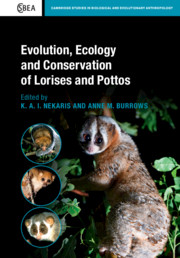Book contents
- Evolution, Ecology and Conservation of Lorises and Pottos
- Cambridge Studies in Biological and Evolutionary Anthropology
- Evolution, Ecology and Conservation of Lorises and Pottos
- Copyright page
- Dedication
- Contents
- Contributors
- Foreword
- Acknowledgements
- 1 Introduction
- Part I Evolution, Morphology and the Fossil Record
- Part II Ecology and Captive Management
- 13 Nutrition of Lorisiformes
- 14 Seeing in the Dark
- 15 Thermoregulation in Lorises
- 16 Home Range, Activity Budgets and Habitat Use in the Bengal Slow Loris (Nycticebus bengalensis) in Bangladesh
- 17 Behaviour of Pottos and Angwantibos
- 18 Positional Behaviour and Substrate Preference of Slow Lorises, with a Case Study of Nycticebus bengalensis in Northeast India
- 19 Sexual Differences in Feeding and Foraging of Released Philippine Slow Loris (Nycticebus menagensis)
- 20 Ranging Patterns of the Pygmy Slow Loris (Nycticebus pygmaeus) in a Mixed Deciduous Forest in Eastern Cambodia
- 21 Utilising Current and Historical Zoo Records to Provide an Insight into the Captive Biology of the Rarely Kept Species Pottos and Angwantibos
- 22 Mother–Infant Behaviours in Greater Slow Loris (Nycticebus coucang) Dyads Consisting of Mothers Pregnant at Confiscation and Their Sanctuary-Born Infants
- 23 Husbandry and Reproductive Management Recommendations for Captive Lorises and Pottos (Nycticebus, Loris and Perodicticus)
- Part III Research, Trade and Conservation
- References
- Index
16 - Home Range, Activity Budgets and Habitat Use in the Bengal Slow Loris (Nycticebus bengalensis) in Bangladesh
from Part II - Ecology and Captive Management
Published online by Cambridge University Press: 29 February 2020
- Evolution, Ecology and Conservation of Lorises and Pottos
- Cambridge Studies in Biological and Evolutionary Anthropology
- Evolution, Ecology and Conservation of Lorises and Pottos
- Copyright page
- Dedication
- Contents
- Contributors
- Foreword
- Acknowledgements
- 1 Introduction
- Part I Evolution, Morphology and the Fossil Record
- Part II Ecology and Captive Management
- 13 Nutrition of Lorisiformes
- 14 Seeing in the Dark
- 15 Thermoregulation in Lorises
- 16 Home Range, Activity Budgets and Habitat Use in the Bengal Slow Loris (Nycticebus bengalensis) in Bangladesh
- 17 Behaviour of Pottos and Angwantibos
- 18 Positional Behaviour and Substrate Preference of Slow Lorises, with a Case Study of Nycticebus bengalensis in Northeast India
- 19 Sexual Differences in Feeding and Foraging of Released Philippine Slow Loris (Nycticebus menagensis)
- 20 Ranging Patterns of the Pygmy Slow Loris (Nycticebus pygmaeus) in a Mixed Deciduous Forest in Eastern Cambodia
- 21 Utilising Current and Historical Zoo Records to Provide an Insight into the Captive Biology of the Rarely Kept Species Pottos and Angwantibos
- 22 Mother–Infant Behaviours in Greater Slow Loris (Nycticebus coucang) Dyads Consisting of Mothers Pregnant at Confiscation and Their Sanctuary-Born Infants
- 23 Husbandry and Reproductive Management Recommendations for Captive Lorises and Pottos (Nycticebus, Loris and Perodicticus)
- Part III Research, Trade and Conservation
- References
- Index
Summary
Tropical forests in Asia have undergone massive declines over the last five decades due to deforestation and subsequent conversion to forest monocultures, agricultural land or other forms of land use (FAO, 2016; Giam, 2017; Hughes, 2017; Meijide et al., 2018; Vijay et al., 2016). The remnant patches of forest are typically degraded, with relatively low tree species diversity compared to the original primary forests (FAO, 2016; Giam, 2017; Vijay et al., 2016). Forests appear to be the most degraded in the Indian subcontinent, with over one billion people occupying the extra-forest matrix, allowing limited or no gene flow between forest patches for some groups of biota (Reddy et al., 2016). This has also created a mosaic of agroforestry–forest patch landscapes where a surprisingly wide range of animals persist, sometimes in large numbers (e.g. Estrada et al., 2017; Flesher, 2015; Nakashima et al., 2013; Nekaris et al., 2017; Pliosungnoen et al., 2010). Canopies are often occupied by a variety of medium to large squirrel species (Squiridae), palm civets (Viverridae) and diurnal and nocturnal primates (Khan, 2015). Collectively, these arboreal species help in pollination of flowers, seed dispersal and sometimes even pest control, suggesting that these assemblages perform important ecosystem functions (Estrada et al., 2012; Estrada et al., 2017; McConkey and O’Farrill, 2016). Unfortunately, current trends in forest destruction and modification forebode rapid and irreversible decline of many species, especially primates, that could lead to loss of forest functions and regeneration potential (Estrada et al., 2017; Johns and Skorupa, 1987; McConkey and O’Farrill, 2016).
- Type
- Chapter
- Information
- Evolution, Ecology and Conservation of Lorises and Pottos , pp. 193 - 203Publisher: Cambridge University PressPrint publication year: 2020
- 1
- Cited by



